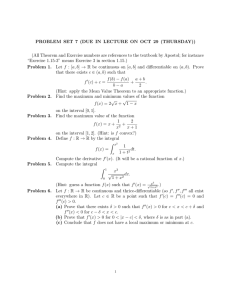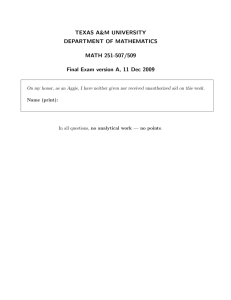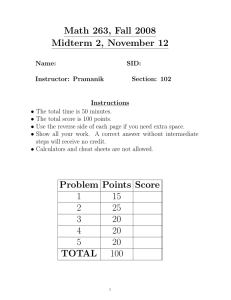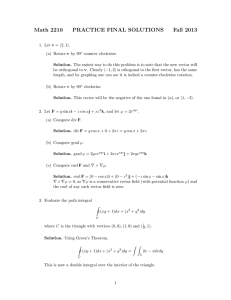Math 2210 PRACTICE FINAL Fall 2013
advertisement
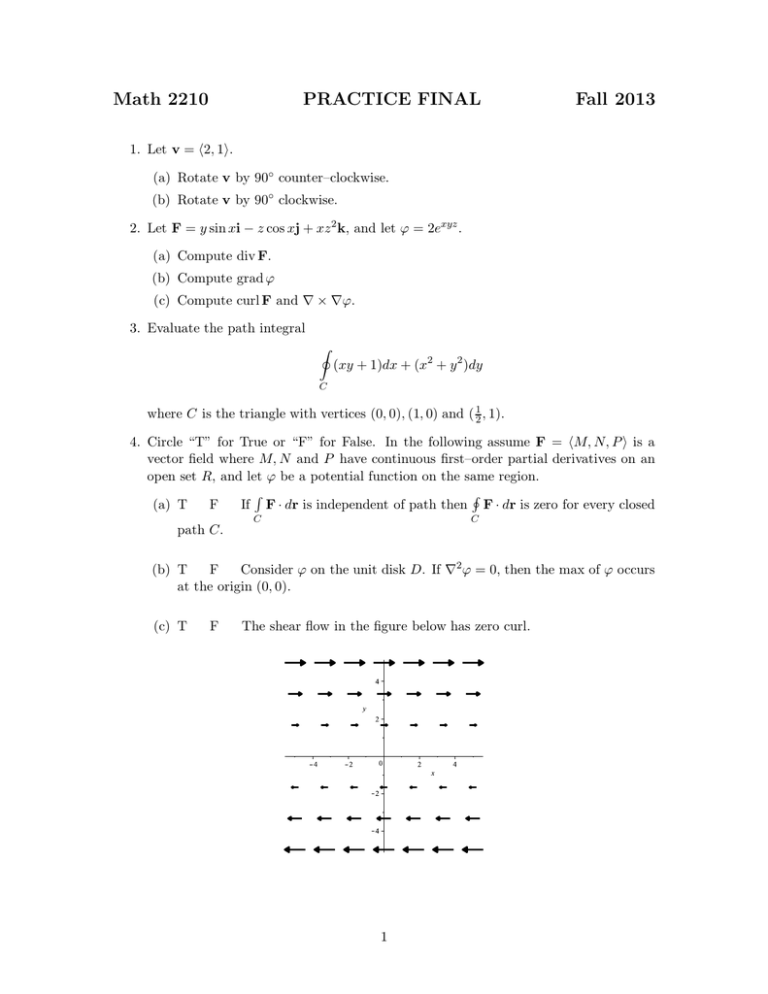
Math 2210
PRACTICE FINAL
Fall 2013
1. Let v = h2, 1i.
(a) Rotate v by 90◦ counter–clockwise.
(b) Rotate v by 90◦ clockwise.
2. Let F = y sin xi − z cos xj + xz 2 k, and let ϕ = 2exyz .
(a) Compute div F.
(b) Compute grad ϕ
(c) Compute curl F and ∇ × ∇ϕ.
3. Evaluate the path integral
I
(xy + 1)dx + (x2 + y 2 )dy
C
where C is the triangle with vertices (0, 0), (1, 0) and ( 21 , 1).
4. Circle “T” for True or “F” for False. In the following assume F = hM, N, P i is a
vector field where M, N and P have continuous first–order partial derivatives on an
open set R, and let ϕ be a potential function on the same region.
R
H
(a) T
F
If F · dr is independent of path then F · dr is zero for every closed
path C.
C
C
(b) T
F
Consider ϕ on the unit disk D. If ∇2 ϕ = 0, then the max of ϕ occurs
at the origin (0, 0).
(c) T
F
The shear flow in the figure below has zero curl.
1
5. Use Green’s Theorem to compute the area of any region S in the plane where the
boundary of S, ∂S is a simple closed curve. That is show
I
A(S) = F · T ds.
∂S
where F = − 12 yi + 12 xj. (Hint: See Example 2 and Example 5 in §14.4 of your
textbook)
6. Consider the force field F(x, y) = h2xy, x2i. Find
Z
W = F · dr ,
Γ
the work done in moving an object in this field from the origin (0, 0) to (1, 1) along
the parabolic arc Γ described by the graph of y = x2 connecting these two points.
(Hint: Determine whether this force is conservative, and use a potential function to
find the integral if it is. Otherwise, parameterize the arc and compute it directly.)
7. Let Ω ⊂ R2 be the disk of radius 2, Ω = {(x, y) ∈ R2 : x2 + y 2 ≤ 4}. Consider the
fluid velocity field v(x, y) = h−y 3 , x3 i on Ω.
(a) Find the curl of the fluid velocity, ∇ × v.
(b) Use Green’s Theorem to evaluate the circulation of v around the boundary of Ω.
That is, find the line integral
I
v · dr.
∂Ω
around the circle of radius 2 forming the boundary ∂Ω of the disk Ω, traversed in
the counterclockwise direction, by using your result from (a) in the area integral
from Green’s Theorem.
8. Suppose that an object of mass m is moving along a smooth curve C given by
r = r(t) = x(t)i + y(t)j + z(t)k,
a ≤ t ≤ b.
under the influence of a conservative force F(r) = ∇f (r). From physics, we learn
three facts about the object at time t
(a) F(r(t)) = mr00(t)
(Newton’s Second Law)
(b) KE = 12 m||r0(t)||2
(kinetic energy)
(c) P E = −f (r)
(potential energy)
Use the above to prove
d
(KE + P E) = 0.
dt
That is that energy is conserved over time. (Hint: See page 747 of your text.)
2
9. Use the Divergence Theorem to evaluate the flux integral
ZZ
F · n dS
∂Ω
where F = (x − 2xy)i + y 2 j + 3zk and Ω is the solid sphere of radius 3 centered at the
origin.
10. Compute the flux through the unit sphere for the vector field F(r) = r.
11. Solve Laplace’s equation explicitly in one dimension,
uxx =
d2 u
= 0.
dx2
Consider a harmonic function u(x) solving the above equation on the interval [a, b].
Demonstrate by graphing u(x) that it attains its maximum and minimum values on
the boundary of [a, b].
12. Evaluate the surface integral
ZZ
(x2 + y 2 ) dS
G
where G is the part of the paraboloid z = 1 − x2 − y 2 that projects onto the region
R = {(x, y) : x2 + y 2 ≤ 1}.
13. Let S be the solid determined by 1 ≤ x2 + y 2 + z 2 ≤ 4, and let F = xi + (2y + z)j +
(z + x2 )k. Evaluate
ZZ
F · n dS
∂S
14. Consider the potential energy of a harmonic oscillator in three dimensions given by
ϕ(x, y, z) =
k 2
x + y2 + z2 .
2
(a) Find the force F(x, y, z) = −∇ϕ at a given position r = (x, y, z).
(b) What are the equipotential surfaces (level sets)?
(c) Find the divergence and curl of F, that is, find ∇ · F and ∇ × F.
(d) Use the divergence theorem for F over Ω = {(x, y, z) ∈ R3 : x2 + y 2 + z 2 ≤ a2 },
the ball of radius a, and your result from (b), to find the flux
ZZ
F · n dS
∂Ω
of F through the spherical surface ∂Ω = {(x, y, z) ∈ R3 : x2 + y 2 + z 2 = a2 }.
3

